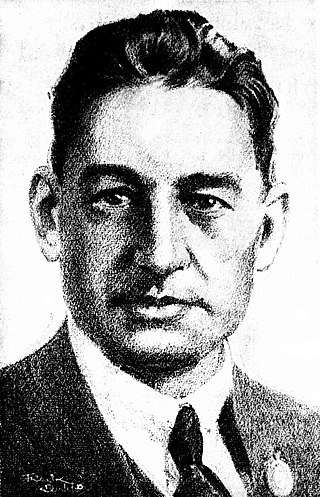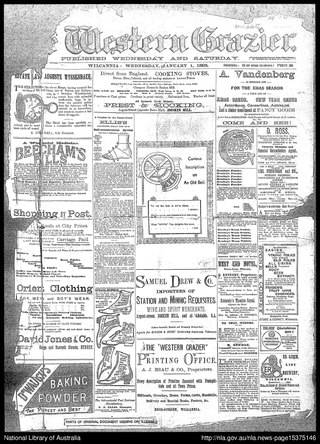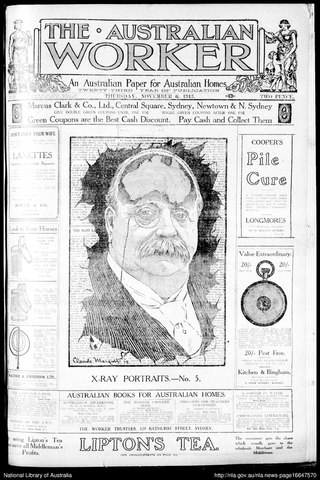Related Research Articles

Clarence Michael James Stanislaus Dennis, better known as C. J. Dennis, was an Australian poet and journalist known for his best-selling verse novel The Songs of a Sentimental Bloke (1915). Alongside his contemporaries and occasional collaborators Henry Lawson and Banjo Paterson, Dennis helped popularise Australian slang in literature, earning him the title "the laureate of the larrikin".
The Register, originally the South Australian Gazette and Colonial Register, and later South Australian Register, was South Australia's first newspaper. It was first published in London in June 1836, moved to Adelaide in 1837, and folded into The Advertiser almost a century later in February 1931.

Harold Frederick Neville Gye, was a prolific Australian artist, cartoonist and caricaturist under the name Hal Gye and a writer of verse and short stories under James Hackston. Gye's artwork was published in a number of newspapers and magazines including The Bulletin, a journal with which he had a long association both as an artist and a writer. Gye was also a noted book illustrator. His artwork was featured in the books of C. J. Dennis beginning with The Songs of a Sentimental Bloke in 1915 and he also illustrated books of verse by Will H. Ogilvie and Banjo Paterson. As 'James Hackston' Gye wrote verse and autobiographical short stories published in The Bulletin and the Coast to Coast series of anthologies. In 1966 his collected short stories were published as Father Clears Out.

Cecil Lawrence Hartt was an Australian cartoonist and caricaturist. As a wartime artist, he popularised the concept of the Australian digger as independent, easy-going and disrespectful of authority, with a sardonic attitude to life. He was the first artist to be employed by Smith's Weekly in 1919, continuing in that role until his death in 1930. Over his career Hartt produced a large number of cartoons on a broad range of subjects and themes; his drawings encompassed political, social and military topics and were admired for their observational humour and the quality of his character portraits. He mainly drew single-panel cartoons, but his body of work also includes early examples of Australian comic strips. Hartt was the first president of the Australian Black and White Artists' Club, formed in July 1924.
Frank Beaumont "Beau" Smith, was an Australian film director, producer and exhibitor, best known for making low-budget comedies.
Samuel Moss Solomon was an early Jewish settler in Australia, amongst whose descendants many achieved a degree of notability. The relationship between these descendants is complicated by three factors: the duplication of names, not only within a family line but across lines; the number of intra-family marriages; and marriages to people with the same surname but not closely related. This list is not exhaustive but includes most family members likely to be found in Wikipedia and Australian newspapers.
The Herald was a weekly trade union magazine published in Adelaide, South Australia between 1894 and March 1910; for the first four years titled The Weekly Herald. It was succeeded by The Daily Herald, which ran from 7 March 1910 to 16 June 1924.

The Bunyip is a weekly newspaper, first printed on 5 September 1863, and originally published and printed in Gawler, South Australia. Its distribution area includes the Gawler, Barossa, Light, Playford, and Adelaide Plains areas. Along with The Murray Pioneer, The River News, and The Loxton News,The Bunyip was now owned by the Taylor Group of Newspapers and printed in Renmark.

The Western Grazier was a newspaper published from 1880 until 1951, covering the central Darling River region of New South Wales. It was published in Wilcannia until 1940, when it moved to Broken Hill.
Table Talk: A Journal for Men and Women, was a weekly magazine published from 26 June 1885 until September 1939 in Melbourne, Australia. It was established in 1885 by Maurice Brodzky (1847–1919), who obtained financial assistance to start his own publication after resigning from The Herald.
The Courier is a weekly newspaper published in Mount Barker, South Australia. For much of its existence its full title was The Mount Barker Courier and Onkaparinga and Gumeracha Advertiser, later shortened to The Mount Barker Courier.
The Advocate was a weekly newspaper founded in Melbourne, Victoria in 1868 and published for the Catholic Archdiocese of Melbourne from 1919 to 1990. It was first housed in Lonsdale Street, then in the grounds of St Francis' Church, and from 1937 in a'Beckett Street, Melbourne.

The Australian Worker was a newspaper produced in Sydney, New South Wales for the Australian Workers' Union. It was published from 1890 to 1950.
The Gadfly was a weekly magazine produced in Adelaide, South Australia between February 1906 and February 1909, founded by the poet C. J. Dennis.
The Voice was a short-lived weekly political newspaper published by J. Medway Day in Adelaide, South Australia from December 1892 to December 1893, and whose last issue was in August 1894.
The Port Adelaide News was a newspaper published in Port Adelaide, South Australia between 1876 and 1933 with various sub-titles, several breaks in publication and periods of bi-weekly publication.

The Kapunda Herald was a newspaper published in Kapunda, South Australia from 29 October 1864 to 25 January 1951. From 1864 to 1878 the masthead was subtitled "and Northern Intelligencer". It was published weekly, except for the period February 1872 to September 1894 when it appeared bi-weekly. When closed, the newspaper was merged with the Barossa News to become the Barossa and Light Herald.
Eustace Reveley Mitford was a satirical writer, best known as "Pasquin", prominent in the early days of the Colony of South Australia.
The World was a British weekly paper, published in London from 1874 to 1920. It was founded by Edmund Hodgson Yates (1831–1894) and E. C. Grenville Murray (1824–1881) and became one of the leading society papers with investigative reports, gossip and an intimate style of journalism. Among its staff and contributors were William Archer, Wilkie Collins and Bernard Shaw.
South Australian Literary Societies' Union (1883–1926) was a peak or advocacy organisation of literary societies in South Australia. It organised competitions between the member societies and established a "Union Parliament" to debate issues of the day.
References
- ↑ "With his bloomin' honors thick upon him". The Critic. 25 September 1897. p. 11. Retrieved 27 March 2016.
- ↑ "The Critic — The Federal Weekly". The Critic. 28 May 1924. p. 1. Retrieved 27 March 2016.
- ↑ "Literary Notes". The Southern Cross . Vol. XXXVI, no. 1803. South Australia. 13 June 1924. p. 4. Retrieved 28 March 2016– via National Library of Australia.
- ↑ "The Insect". The Newsletter: an Australian Paper for Australian People . Sydney. 18 November 1905. p. 13. Retrieved 8 January 2016– via National Library of Australia. The writer has a poor opinion of Mr. Dennis.
- ↑ Conrad Constantine Eitel (c. August 1880 – May 1947), who was born in Hong Kong to a naturalised German-born father (a minister and lecturer at University of Adelaide) and English mother née Eaton, was later (August 1911) appointed secretary for Douglas Mawson's Antarctic Expedition, enlisted in 1914, two days after war was declared, joined the Expeditionary Force (a six month contract) and embarked for Rabaul on 19 August 1914. He applied for a commission, but was barred from service on account of his German parentage. He changed his name to Lionel Lambert Eaton and enlisted in August 1915. He was discharged in February 1916 on the grounds of giving a false answer in his application.